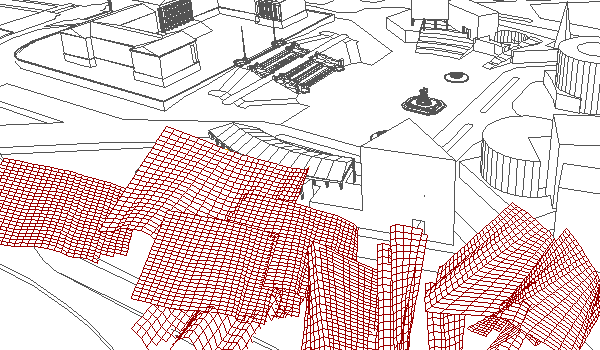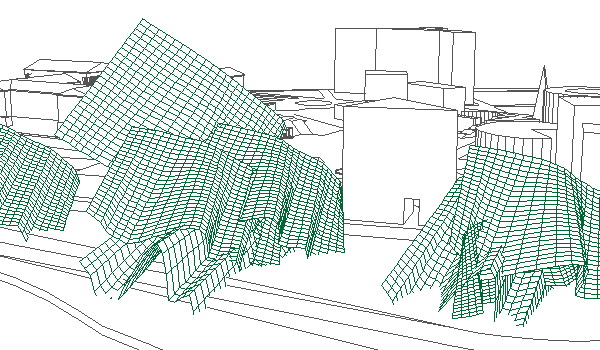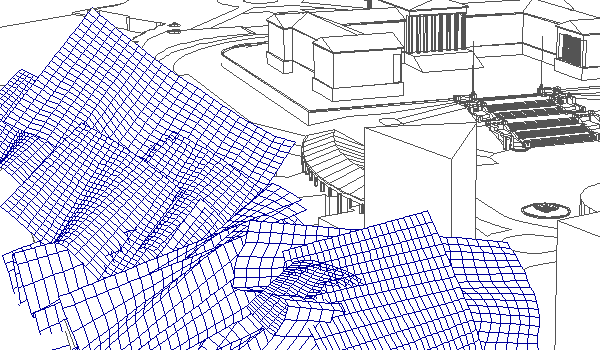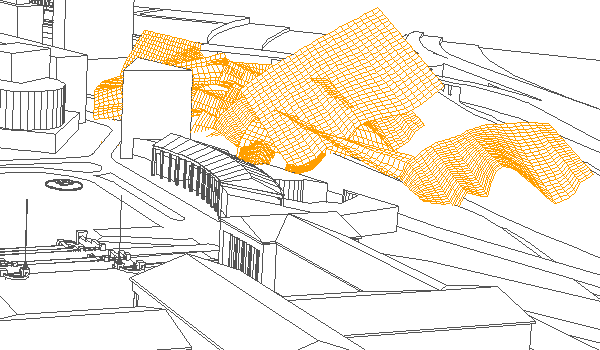2000.08.09
Bilbao "Affect" 001
Ichnographia Quondam.
project: The Working Title Museum
site: east bank of the Schuylkill River, Quondam




| |
2000.08.15
Learning from Lacunae: a progressive inquiry of the acquisition of knowledge via reflection on what is not there
2000.08.20
dtm - new work
I (finally) got around to wireframing the mesh surfaces generated earlier this year, and I also deleted virtually all of the earliest surfaces I generated because they were mostly overwrought with grid quadrants and not very modular. I'm utilizing the freeze triangle command (with edge display = 1) to generate the wireframe lines, and the process is very effective and not at all tedious. That is the main reason that I'm going to focus on mesh surfaces over the next few days, because I can now compile a library of many wireframe surfaces. I also streamlined the surface generation process on the old system by using sketch lines instead of spline lines.
2000.08.20
Ichnographia Quondam: agenda
Part of the reason for getting a collection of mesh surfaces organized is to then begin further work on the Working Title Museum within IQ.
2000.09.03
Re: collision architectures
Reintroduce collision architecture from early 1997 at the new Quondam. This time, however, along with the original presentation, there will also be a new, more vivid set of images (perhaps many in animation). After newly deforming and colliding Savoye and Weber, record the results from various angles.
2000.09.03
Frei Otto and Free Otto Architectures
...present pictures of the 1972 Olympics site next to captured images of the rotate extruded forms...
"the free ottopology of Ottopia" ...relates to the dexterity and schizophrenia of rotated surface extrusions, at least my version of the phenomenon and data manifestation...
...the notion of hypersurface versus a new hyperform architecture...
2000.09.25
ideas
2. mesh surface "sculptures" up and down the Parkway.
3. mesh surfaces "bonded" via "walls", "towers", and "floors", etc., e.g., Hejduk architecture ideas; new typologies.
4. Quondam model collection Interrotta.
5. an orbital Ichnographia Campi Martii?
2000.10.02
ideas
Architecture's Duchamp.
The ongoing (progressive) history of the circle-square juncture.
A digital collage architecture publication...
The Architecture of Virtual Eventuality
| |
2000.10.05 21:21
Re: architectural photography
I think architectural photography is extremely valuable when the architecture in photographs no longer exists but in photographs.
Just over three years ago I went to photograph Venturi & Rauch's big BASCO 'sign' building. The building was then derelict, and I took many 'unflattering' snapshots, e.g., lots of empty beer bottles and a plump vinyl lounge chair provideing an interesting domestic tableau just behind the big 'A'. Alas the film did not develop at all, and hence no photographic record and just a memory for me. Almost exactly a year later I returned to BASCO to take pictures again, however, the big letters were that time completely gone. I turned out to be the person informing Venturi's office of the loss.
The point is that 1) many buildings today change radically in short periods of time, therefore ALL photographic records (not just the flattering ones) are important items in understanding the 'life' of architecture most fully, and 2) a photograph of a building that once was but is no more is perhaps the easiest form of virtual architecture invented thus far.
2000.10.07 12:18
non-Euclidean geometry
Non-Euclidean geometry, that term oft-used but not exactly understood by many of today's non-orthogonally 'inclined' architects and theorists, stems from the many age-old mathematical attempts to disprove one of Euclid's axioms:
"There was in particular one axiom, the axiom of parallels, which they disliked and attempted to eliminate. The axiom states that through a given point one and only one parallel can be drawn with respect to a given line; that is, there is one and only one line that does not ultimately intersect with a given line and yet lies in the same plane." (from H. Reichenbach, The Rise of Scientific Philosophy, 1951.)
With the discovery that light does not travel in a straight line, the notion that parallel lines can then (eventually) intersect seems to disprove Euclid's parallel axiom.
Another aspect of non-Euclidean geometry is that the sum of the angles inside a triangle can add up to more that 180 degrees, but such triangles only truly exist when the area of the triangle is extremely vast, say a triangle created by connecting three galaxies.
Basically, it is still Euclidean geometry that governs what architects on Earth are capable of building.
As an aside, I remember reading that Gehry's office, when first dealing with designs that collaged many non-orthogonal surfaces and forms, resorted to 'descriptive geometry'.
2000.10.07 17:03
Re: geometry notes
Could it be that human perception of space may be non-Euclidean, but that human imagination has evolved (so far) in a very Euclidean manner?
2000.10.10 10:54
Plea for Euclid - some comments
Just read Cache's "Plea for Euclid" (in ANY 24) and here are some comments:
1. the outline of the history of Euclidean and non Euclidean geometry that Cache provides in the initial portion of the essay is virtually the same history available 50 years ago (e.g., "The Nature of Geometry" in Reichenback's The Rise of Scientific Philosophy). Without being explicit about it, Cache too seems to feel that the recent architectural (avant-garde) notion of using non-Euclidean geometry is in need of correction and clarification.
2. Cache briefly mentions the problems (often) encountered with CAD-CAM produced parts machined to extremely low tolerances that, when assembled on site, have difficulties fitting together. Cache has made a career as a CAD-CAM designer, so I believe anything he says on that subject is worth a listen. I found myself wondering whether architects should be taught more about physical world tolerances before learning about sophisticated geometries. I then also found myself thinking that by and large architects are trained to be extremely intolerant of anything that doesn't 'fit' properly. (Should the new schools of architecture be schools of tolerance?)
3. the latter half of Cache's essay provides a (so far) unique analysis of the 'natural' geometric deformities that CAD-CAM engenders, and it is here the 'plea for Euclid' comes through. Essentially, Cache finds that all kinds of strange and unexpected geometries manifest themselves within the very Euclidean system of CAD-CAM.
4. In the end, it is interesting that Cache very much advocates a study of 'parallels'.
| |
2000.10.16 19:10
baroque (cyber?) theater
The following is a passage I first read over 23 years ago. It comes from Timothy K. Kitao, Circle and Oval in the Square of Saint Peter's: Bernini's Art of Planning (New York: New York University Press, 1974), pp.22-23. I was reminded of this passage after some reflection upon the recent bit of cyber theater that occurred here a month and a half ago.
"In the well know production of the Due Teatri, first given in 1637, Bernini developed a simulated amphitheater of a very elaborate kind. This is, of course, the best known of Bernini's theatrical works, but a recapitulation is in order.
According to Massimiliano Montecuculi, who witnessed the performance, the stage was prepared with "a flock of people partly real and partly feigned" so arranged that, when the curtain had fallen for the opening of the play, the audience saw on the stage another large audience who had come to see the comedy. Two braggarts, played by Bernini himself and his brother Luigi, then appeared on the stage, one facing the real audience and the other the fictitious; and recognizing each other in no time, they went on to claim, each in turn, that what the other saw as real was actually illusory, each firmly convinced that there was no more than one theater with its audience in that half he was facing. The confusions of realities in mirror image thus heightened, the two firmly decided "that they would pull the curtain across the scene and arrange a performance each for his own audience alone." Then the play was performed to the real audience, that is, the main act to which that preceded was only a present prelude. But through the play another performance was supposed to be taking place simultaneously on the second stage introduced by Luigi; the play was, in fact, interrupted at times by the laughter from those on the other side, as if something very pleasant had been seen or heard.
At the end of the play, the two braggarts reappeared on the stage together to reaffirm the "reality" of the illusion. Having asked each other how they fared, the impresario of the fictitious performance answered nonchalantly that he had not really shown anything but the audience getting up to leave "with their carriages and horses accompanied by a great number of lights and torches." Then, drawing the curtain, he displayed the scene he had just said he had shown to his audience, thus rendering complete the incredible reversal of reality and illusion to the confused amazement of the real spectators, who were now finding themselves ready to leave and caught in the enchanting act of feigning the feigned spectators."
2000.10.22 14:47
Re: AR:Evo Model (brown 2)
Is the more aesthetic problem, perhaps, the ongoing (generational?) process of institutionalize evasion itself? And hasn't the 20th century already well proven that humanity's artists now overwhelming treats art via what it COULD be rather than what it SHOULD be? And just maybe the biggest problem for architecture (and architectural aesthetics) today is its struggle making the methodological/critical shift for what should be architecture to what could be architecture.
2000.11.01
quick idea
New history of the Baroque (fortifications to double theaters).
|